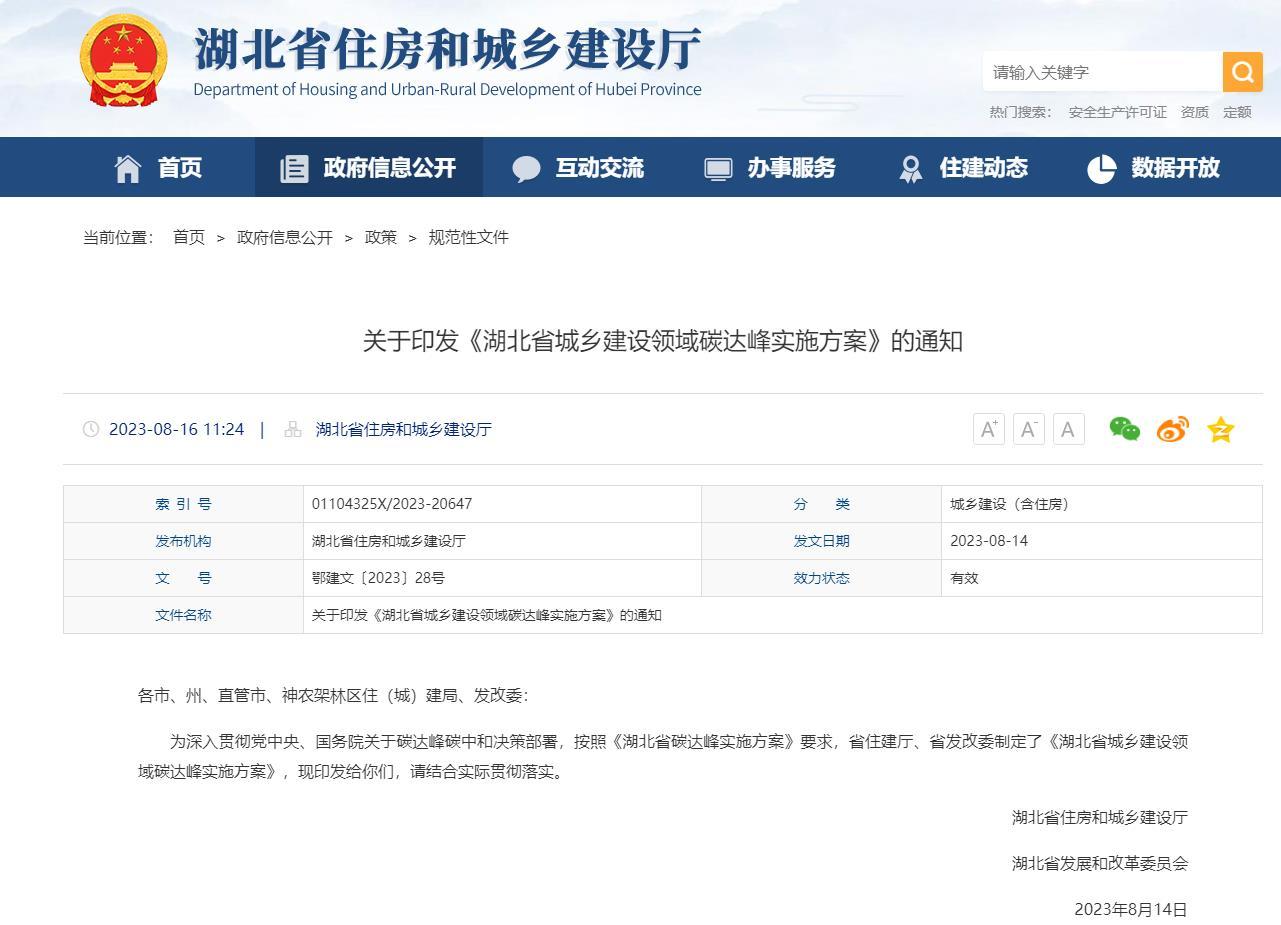21
2023
-
08
Implementation Plan of Carbon Peak in Urban and Rural Construction in Hubei Province in 2023
Promotion of "self-insulation, integration, the same life" of the external wall insulation system. By 2025, the energy efficiency level of new buildings will be increased by 15%; By 2030, the new residential building body will meet 75% of the energy-saving requirements, and the new public building body will meet 78% of the energy-saving requirements.
The field of urban and rural construction is a major carbon emitter. On August 16, the Provincial Department of Housing and Urban-Rural Development and Reform Commission jointly issued the "Hubei Province Urban and Rural Construction Field Carbon Peak Implementation Plan", which clarified the overall goals and eight key tasks.
The plan proposes that carbon emissions in the province's urban and rural construction will reach a peak before 2030. The institutional mechanism and policy system for green development in urban and rural construction have been basically established, all new civil buildings in cities and towns have been built into green buildings, the efficiency of building energy utilization has been further improved, and the growth trend of building energy consumption and carbon emissions has been effectively controlled.

The implementation plan defines eight key tasks:
The first is to promote the green and low-carbon development of urban construction. From the three aspects of promoting the construction of green ecological city, improving the operation efficiency of urban infrastructure, and promoting the construction of green low-carbon community, this paper puts forward requirements for urban form, density, functional layout and construction mode, as well as infrastructure construction, urban renewal and garbage disposal, and defines the specific quantitative targets such as the average road density of urban built-up areas and the proportion of green community creation.
The second is to improve the energy efficiency level of new buildings. From the aspects of implementing building energy efficiency standards, promoting ultra-low energy consumption building pilot projects, strengthening building energy-saving transformation and operation management, the key tasks of improving building energy efficiency level are clearly defined, and the target requirement of "increasing the energy efficiency level of new buildings by 15% by 2025" is put forward.
The third is to promote the quality and efficiency of green buildings. The ways and methods of high-quality development of green buildings are clarified from the aspects of in-depth development of green building creation actions, promotion of standardized management of green buildings, and improvement of green building quality.By 2025, the proportion of green buildings in new urban civil buildings will reach 100 percent, and the proportion of star-rated green buildings will reach 20 percent.”。
Four is to strengthen the application of renewable energy. From the aspects of promoting the diversified use of renewable energy and promoting the application of solar energy buildings, it puts forward requirements for the large-scale and efficient application of renewable energy buildings, and makes it clear that "by 2025, the replacement rate of renewable energy in urban buildings will reach 8%".
Five is to strengthen the building energy saving operation management. From the aspects of strengthening the monitoring and management of building energy consumption and improving the energy efficiency of equipment and facilities, strengthening the operation and management of building energy conservation proposes that by 2030, the overall energy efficiency of the electromechanical system of public buildings will be increased by 10% from the current level.
Six is to optimize the structure of building energy. From the implementation of building electrification projects and the development of new building power systems, the energy consumption structure will be further optimized. By 2030, the province's urban building electricity will account for more than 65% of building energy consumption.
Seven is to promote green low-carbon construction. The implementation path of promoting green and low-carbon construction is put forward from the aspects of prefabricated buildings, industrialization and intelligent construction of new buildings, and improving the application of green building materials. It is required that by 2025, new prefabricated buildings in the province account for more than 30% of the new construction area.
Eight is to promote green county and rural construction. Focusing on the aspects of green and low-carbon county towns, creating beautiful and livable villages, and promoting the construction of green and low-carbon rural houses, measures to promote the green development of county towns and villages are proposed, requiring that "by 2025, new rural houses have design plans or adopt standard atlases. The proportion reaches 70%" and other target tasks.
Key content:
(II) to improve the level of building energy efficiency
1. Implement building energy efficiency standards. Strengthen the construction of the standard system, implement the energy efficiency improvement plan for new civil buildings, and improve the energy efficiency standards for new urban civil buildings in stages and types. Advocate buildings to make full use of natural ventilation and natural lighting, promote the application of high-performance doors and windows, and add shading facilities according to local conditions,Promotion of "self-insulation, integration, the same life" of the external wall insulation system. By 2025, the energy efficiency level of new buildings will be increased by 15%. By 2030,The new residential building body reaches 75% energy saving requirementThe new public building body meets the energy saving requirement of 78%.
2. Promote the pilot demonstration of ultra-low energy consumption buildings. We will continue to promote the pilot work of ultra-low energy consumption buildings in "one main and two wings" cities, and encourage other cities to carry out the pilot work simultaneously. Guide state office buildings, large-scale public buildings, government-invested public welfare buildings, and other public buildings where state-owned funds participate in investment and construction, and actively carry out pilot demonstrations of near-zero energy buildings, low-carbon buildings, and zero-carbon buildings. By 2025, the province will complete an ultra-low energy consumption building area of 1.2 million square meters, and the pilot work will form a feasible experience. By 2030, the province will complete an ultra-low energy consumption building area of 3 million square meters.
3. Improve the energy saving level of existing buildings. Combining urban renewal and the transformation of old urban communities, actively carry out energy-saving transformation of existing residential buildings, and guide residents to choose energy-efficient doors and windows, air conditioners and other parts and equipment. We will implement energy-saving renovation of public buildings on a large scale, and encourage qualified large-scale public buildings to be renovated in accordance with green building standards. Explore the market-oriented mechanism of green energy-saving transformation of existing buildings, and promote the government, residents, and social forces to reasonably share the funding mechanism for the transformation. Promote contract energy management, energy cost trusteeship and other models.
Accelerating the Large-scale Development of Green Building in (III)
1. Continue to carry out green building creation actions. Strict green building bottom line control, the province's new civil buildings in accordance with the basic level of green building and above standards. Newly built office buildings of state organs, large-scale public buildings, public welfare buildings invested by the government and other public buildings invested and constructed by state-owned funds shall be constructed in accordance with the standard of two-star and above for green buildings; the newly built indemnificatory housing shall be constructed in accordance with the standard of one-star and above for green buildings. Encourage other civil buildings to be constructed in accordance with high-star green building standards. Actively carry out green building demonstration work and guide the large-scale development of green buildings. By 2025, the proportion of green buildings in new urban civil buildings will reach 100 percent, and the proportion of star-rated green buildings will reach 20 percent.
2. Promote the standardized management of green buildings. Accelerate the legislative work of green building development, further clarify the responsibilities of housing construction, development and reform, natural resources and other departments, and standardize the behavior of the responsible parties of construction, design, and construction. Incorporate the green building development plan into the detailed land space planning, clarify the green building level in the construction land planning conditions, indicate the green building level in the construction project planning permit, and include the construction project planning review and planning condition verification. Strictly implement the "Green Building Design and Engineering Acceptance Standards", and strengthen the supervision of the whole process of design, construction, acceptance, use and maintenance. The implementation of green building logo classification management system, standardize the identification and management of green building logo, establish and improve the logo cancellation mechanism.
3. Improve the low carbon level of green buildings. Pay attention to green building performance design, improve health performance indicators, improve the level of intelligence. Strengthen the research and development of key technologies for green buildings and technical consulting services, and promote the application of new technologies, new processes, new materials, and new equipment for green buildings. Encourage the construction of green building intelligent operation management platform, to achieve real-time monitoring and statistical analysis of building energy consumption and indoor air quality indicators. Improve the operation and management system of green buildings, incorporate the daily operation requirements of green buildings into the content of property management, and improve the operation efficiency of green building facilities and equipment.
(VII) promotes green and low-carbon construction methods
1. Promote assembly buildings. Adjust and expand the scope and area of assembly building implementation, strict project approval, land supply, planning permission, construction permit, completion acceptance control, and promote the active use of steel structure assembly construction in public buildings, infrastructure projects and residential buildings. Fully promote the application of prefabricated internal partition walls, prefabricated stair panels, prefabricated floor panels and insulation prefabricated exterior wall panels and other assembly components.By 2025, the province's new prefabricated buildings will account for more than 30% of the new construction area.Among them, Wuhan City reached more than 50%, Xiangyang City, Yichang City and other recognized national model cities reached more than 40%.
2. Promote the industrialization of new buildings and the development of intelligent construction. Promote the general contracting model, implement the whole process engineering consulting and the architect responsibility system for civil construction projects, and accelerate the reform of project cost. Support the existing assembly production base to implement equipment transformation and upgrading projects to improve the performance and efficiency of construction equipment. Build an advanced and applicable building industrialization and intelligent construction standard system, unify the data standards of engineering construction links, and promote the whole process application of building information model (BIM). Strengthen technology research and development in key areas and the transformation and application of results, and promote the deep integration of new-generation information technology such as BIM, artificial intelligence, and blockchain with engineering construction technology. Co-ordinate construction activities of the whole industry chain collaboration, accelerate the formation of intelligent construction of innovative industrial system. By 2025, the BIM modeling rate of important new buildings and municipal infrastructure will reach 80%.
3. Increase the proportion of green building materials. Promote the use of green building materials in office buildings of state agencies, large-scale public buildings and government-invested public welfare buildings, and implement the regulations that green buildings should be selected to obtain green building materials identification products. Establish and improve the green building materials procurement mechanism for government projects, promote phosphogypsum building materials products according to local conditions, and strengthen the recycling of building materials and the comprehensive utilization of resources. By 2025, the proportion of green building materials used in new urban civil buildings will reach 50%.
Detailed link: http://zjt.hubei.gov.cn/zfxxgk/zc/gfxwj/202308/t20230816_4798719.shtml
Hubei, Carbon Peak


